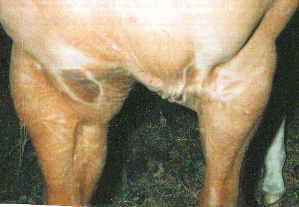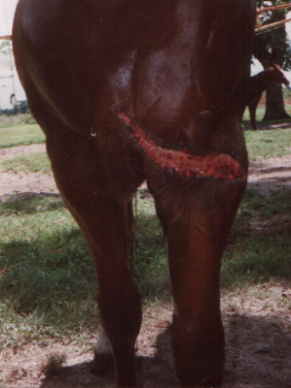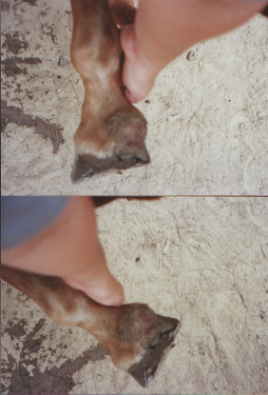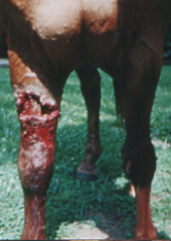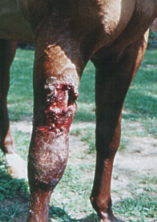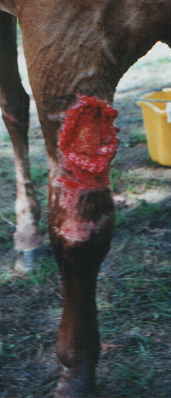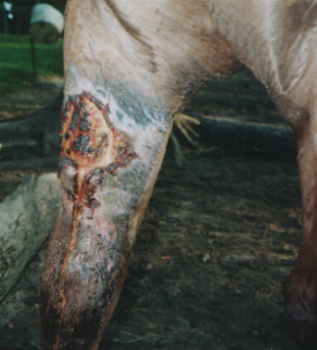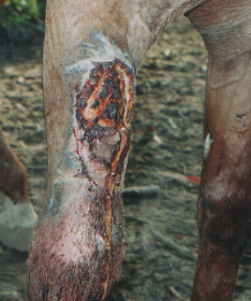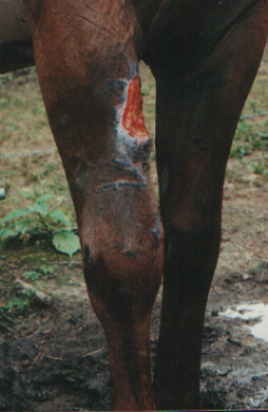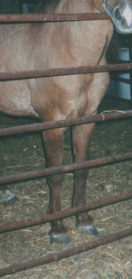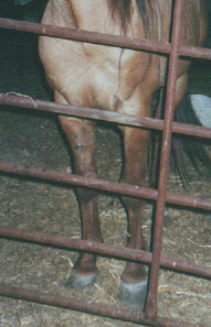 |
 |
 |
|
 |
 |
 |
|
|
|
|
|
web site desigined by:
kim croft web design
|
|
|
|
copyright: Kim Croft 2000; 2006
|
|
|
|
AQHA; NFQHA, Three Bars; Joe Hancock; Blackburn; Pretty Buck; Seminole Charley, Damron One, Ed Echols, Eddie 40; Joe Cody, Bill Cody, Wimpy, King, Hollywood Bill, Hollywood Gold, Doc
Bar, Genuine Doc, Doc Tari, Go Dick Go, Rocket Wrangler, A Sharp Music Note, Gold Chunk IMHR miniature horse,
|
|
|
 |
|
|
 |
 |
|
Horse C: This horse was tangled in a fence. Instead of waiting for help he jumped around until the wire broke. By this time the skin on his his leg had a huge T shaped rip from the upper forearm to
the knee and was pulled completely off the leg muscles and tendons and hanging loose. This wound was sanitized and stitched within 20 minutes of the injury and looked good. All bleeding had stopped and support
bandages were wrapped from healthy tissue upward over injured tissue and on to healthy tissue above. It looked pretty good.
In two to three days the usual happened. The skin started to crumble at the stitches.
Finally the only stitches still holding were the internal ones holding the sinew from cut skin to the sinew of the healthy skin. Finally even those came loose. The leg had swollen as in Horse A and jiggled when he
walked. I just knew this horse was ruined even though by then I knew this remedy worked excellent. This was the first cut we used this on that had a three point tear - with the flaps wanting to fall away due to
gravity.
I took the first photos of the leg about 5 days after the injury. A few stitches were still holding at this point. I took the later photos approximately once a week for a while. The last photo was taken
a while later, about 4 months. The final photos show minimal scarring and no swelling or enlarged joints. The final scars are on the order of those shown on Horse A.
|
|
|
 |
 |
|
First the stitches across the top of the wound gave loose. You can see the pocket made with the skin to the inside of the leg on the photos to the left.His leg is starting to swell.
|
|
|
|
 |
 |
|
The photos to the left are later in the week. The verticle stitching had given way and the stiff, gnarly skin flap insisted on hanging down. The oozing fluid and swelling caused some of his hair and skin
to slough off.
As you can see, these wounds will look worse before they get better.
The two photos below were taken about 1 week later. This wound was never re-stitched. The yellow seam from the
oval part of the wound downward is the verticle part of the tear. The dark looking skin around the wound was where the skin had been pulled off the muscle of the leg. All the skin over his knee area
looks dead with amost no hair. At this point his leg,
|
|
|
|
 |
 |
|
was swollen from his pastern up to and across his chest. The skin separated and split under the large oval opening making a triangle of dead skin. His skin was so tight across his chest I thought he was
going to lose hair there also, he didn't.
|
|
|
|
 |
 |
|
Approximately 1 month after the initial injury. The swelling finally stops getting worse and actually goes down some. The wound and surrounding is starting to look like living tissue. We are on the down
hill side of it now.
As you can see, the flap of skin that stuck out from the leg is now almost flush with the leg. The weight of the lower skin is what has caused the bottom of the horizontal edge to
be so far from the top of the horizontal (now curved) edge of the tear. Three to four more weeks of less than two minutes of wound care daily and we were done.
|
|
|
|
 |
 |
|
Photos to the left: After the leg was all healed the scars were no worse than those shown in Horse A.
It took a few months after that for all the hair to finish growing back - but it did all grow back
except for some very minor scars along the lines of Horse A.
Notice the horizontal scar is a mere line, not a big spot. The skin and scar is flush against the leg muscle and all swelling is gone.
This horse was a reall trooper. He never limped or complained through out the whole process. No twitch or "sleepy shots" were necessary.
|
|
 |
 |
|
Additional Information:
|
 |
 |
|
I have had the same, excellant results with bad puncture wounds (impaled on a tractor hay fork in the stifle muscle area; 2 X 6 board through the front of the chest where it meets the upper inside leg - about 12
inches deep - left a hairline scar approx. 1 inch in length; among many many others). All have had the same, excellant results. These wounds do not even become infected. Most have happened in the summer when heat
and flies are the worst. Fly repellant and ointment is not needed, in fact discouraged on the wound. Flys naturally stay away from the treated area.
I have told others about this incredible process. Most look at
me like I've lost my mind. Very few have used it. I have seen many horses that have had wounds turn into ugly scars, usually with proud flesh that could have been avoided. This procedure is so inexpensive and simple
I can not believe they won't try it. Even when shown the photos I have posted above.
After much thought and consideration I decided it is because most folks apparently feel anything (even information) given away
free must not be worth much. Therefore I have decided to write down the ingredients, basic wound care and product application on paper. I was going to package the three ingredients and just sell the stuff but after
you read the ingredient listing on my paper you will see why I just couldn't do it. The three items are so easy to obtain by virtually anyone living anywhere I decided to sell the paper instead.After the first few
applications MOST horses will just stand and let you apply the ingredients without a hassle. Even horses known for being uncooperative in general.
For a one time cost of $20 and a self addressed stamped envelope I will send a complete ingredient list and detailed instructions to take your wound from the before to the after photos above.I also accept payment
through PayPal. Make checks and moneyorders payable to Kim Croft.
Please note I am not a veterinarian and always advocate contacting your veterinarian in the event of any emergency or for animal health questions. This web-site copy is exclusively under copyright by Kim Croft.
|
|
|
 |
 |
|
I do accept payment by credit card and check with a valid e-mail address through PayPal. Use
e-mail: kcroft99@yahoo.com
|
|
 |
 |
|
copyright: Kim Croft 2004; 2006
|
|
